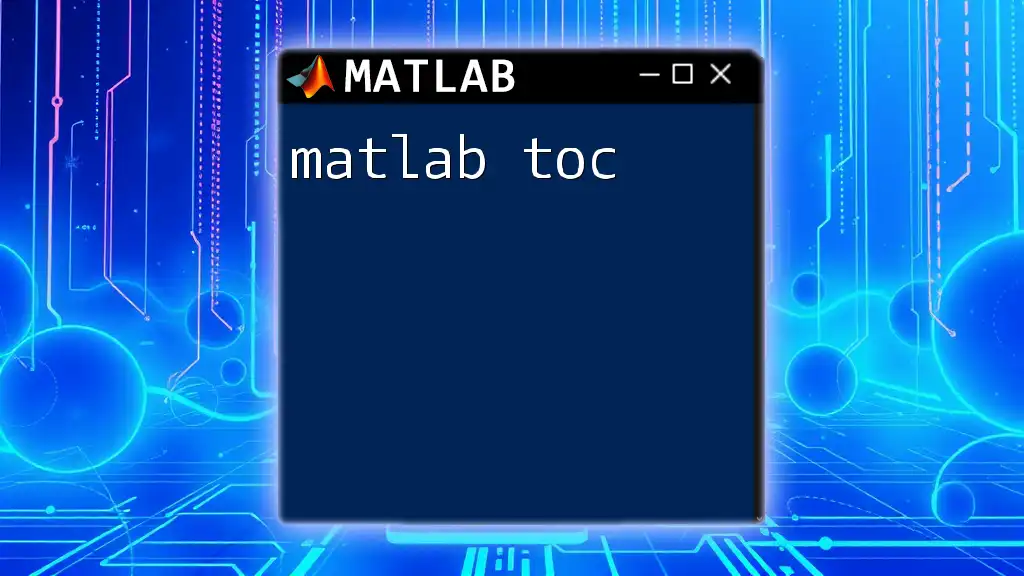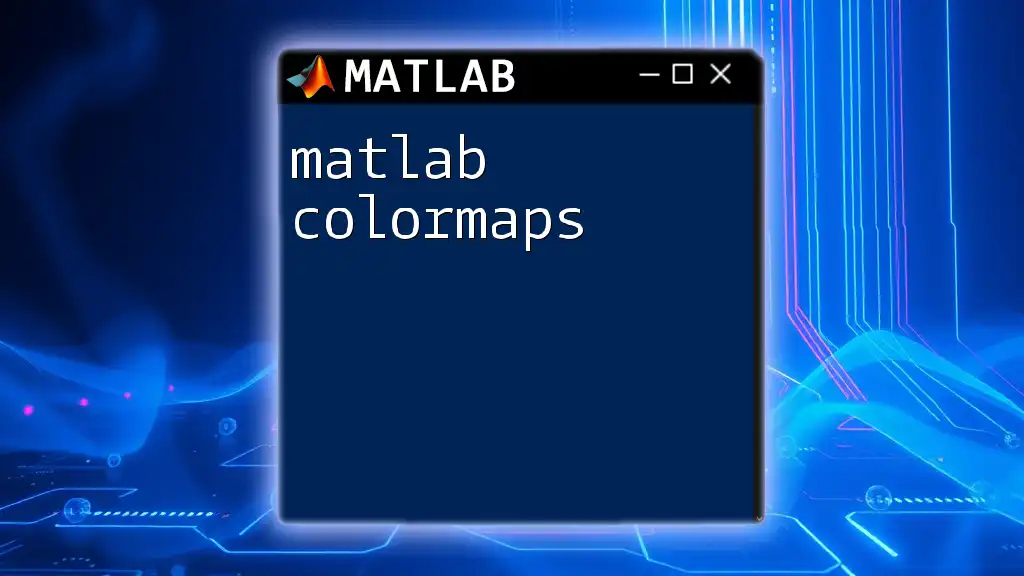The `toc` function in MATLAB is used to measure the elapsed time since the last call to `tic`, allowing you to benchmark code execution efficiently.
tic; % Start timer
% Your MATLAB code here
pause(2); % Simulate code execution with a 2-second pause
elapsedTime = toc; % Stop timer and get elapsed time
fprintf('Elapsed time is %.2f seconds.\n', elapsedTime); % Display elapsed time
Understanding `toc` in MATLAB
What is `toc`?
The `toc` function in MATLAB is a simple yet powerful command used to measure elapsed time from a previous `tic` command. It's an essential tool for any MATLAB programmer looking to gauge how long a specific operation takes to execute. Understanding how to properly use `toc` can greatly enhance your ability to optimize code and improve performance.
The Importance of Timing in MATLAB
Timing is a critical aspect of programming. Knowing how efficiently your code runs allows you to identify bottlenecks and optimize performance. In conditions where algorithms are processing large datasets or performing extensive calculations, efficient time measurement becomes crucial. Utilizing `toc` helps you better manage resources and enhances the overall speed of your applications.

Getting Started with `toc`
Basic Usage of `toc`
Using `toc` is straightforward. Begin your timing with the `tic` command, and then call `toc` when you want to check how much time has elapsed. The typical syntax is simple:
tic; % Start the stopwatch
pause(2); % Simulate long computation
elapsedTime = toc; % Stop the stopwatch and store the time
disp(elapsedTime); % Display the elapsed time
In this example, `tic` starts the timer, then the `pause(2)` command simulates a computation that takes about two seconds. When `toc` is called, it stops the timer and returns the elapsed time to the variable `elapsedTime`, which is then displayed.
When to Use `toc`
The `toc` command is ideal for measuring execution time in various scenarios, such as:
- When optimizing code for performance.
- To compare different algorithms for the same task.
- To benchmark functions or scripts before and after optimization efforts.
While `toc` is a high-level tool that provides simple timing capabilities, it's essential to recognize situations where more advanced profiling tools may be more appropriate.

Advanced Usage of `toc`
Combining `tic` and `toc` with Loops
One of the valuable applications of `toc` is measuring execution time within loops. This can help analyze which iterations may be causing slowdowns. For example:
for i = 1:5
tic;
pause(i); % Simulate varying computations
elapsedTime = toc;
fprintf('Elapsed time for iteration %d: %.2f seconds\n', i, elapsedTime);
end
In this snippet, we loop from 1 to 5, and for each iteration, we start a timer with `tic`, simulate a computation that “pauses” for `i` seconds, and then check the elapsed time with `toc`. This demonstrates how each iteration’s performance can vary and highlights the flexibility of `toc` in loop structures.
Nesting `tic` and `toc`
Nesting `tic` and `toc` is another powerful feature, allowing you to measure execution times of multiple levels of code. Here’s an example:
tic;
for i = 1:3
tic;
pause(i); % Simulate computation for each iteration
iterationTime = toc;
fprintf('Elapsed time for inner loop iteration %d: %.2f seconds\n', i, iterationTime);
end
totalElapsedTime = toc; % Total elapsed time
disp(['Total elapsed time: ', num2str(totalElapsedTime)])
This code measures both the elapsed time for each individual iteration (the inner `tic-toc`) and the total elapsed time for the entire loop (the outer `tic-toc`). This structure provides comprehensive insights into where time is being spent within your operations.

Best Practices for Using `toc`
Tips for Accurate Timing
For optimal results from your timing measurements, consider these tips:
- Minimize the influence of other commands: Functions like `disp`, that print to the console, can introduce variable delays. Avoid putting I/O operations between `tic` and `toc`.
- Run multiple tests: Execute the loop or function several times to account for variations in timing. Average the results to get a more reliable estimate.
- Ensure consistent conditions: Try to run timing tests under similar system states, with minimal background processes, for consistency.
Performance Optimization Techniques
Using `toc` allows you to identify performance bottlenecks effectively. You may visually inspect output logs to spot unexpected slowdowns, or run portions of your code individually to quantify performance.
While `toc` is useful for high-level timing, consider MATLAB’s `profile` function for more comprehensive profiling. Use `profile` for a detailed analysis of function calls and execution time, then use `toc` for quick checks on specific operations.

Real-World Applications of `toc`
Timing Data Processing
To illustrate `toc` in a practical scenario, consider measuring the time it takes to process large datasets. For instance:
data = rand(1, 1e6);
tic;
sortedData = sort(data); % Time taken to sort data
elapsedTime = toc;
disp(['Time taken to sort data: ', num2str(elapsedTime)]);
This example generates a random dataset and sorts it, measuring the elapsed time to perform the sorting operation. Such timing measurements can help developers fine-tune algorithms for efficiency.
Utilizing `toc` in Function Performance
Measuring the performance of user-defined functions is another common application of `toc`. Here’s how you could do it:
function result = myFunction(x)
tic;
result = sum(x);
elapsedTime = toc; % Time taken to compute sum
disp(['Time taken to execute myFunction: ', num2str(elapsedTime)]);
end
By adding `tic` and `toc` around the sum computation within `myFunction`, you’ll be able to gauge how long the operation takes, helping developers optimize their functions based on real execution data.

Conclusion
To summarize, the MATLAB `toc` function serves as an invaluable tool for measuring elapsed time in your scripts and functions. By understanding its use and incorporating best practices for timing, you can uncover insights that lead to improved code efficiency and performance optimization.
I encourage you to experiment with `toc` in your projects—measure, analyze, and refine. Timing can often reveal unexpected behavior in your code, making it easier to optimize further and create efficient MATLAB applications.

Additional Resources
For further learning about `toc` and timing techniques in MATLAB, consult the official MATLAB documentation and user guides. Engage with online learning platforms that offer tutorials about MATLAB performance optimization or join community forums for MATLAB users, where knowledge sharing can significantly enhance your coding proficiency.

















